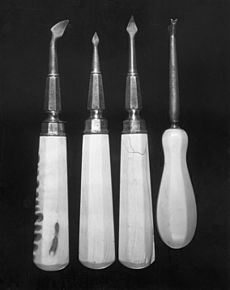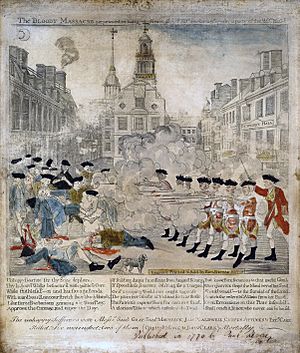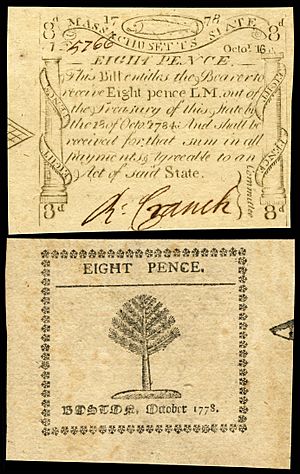Paul Revere facts for kids
Quick facts for kids
Paul Revere
|
|
|---|---|
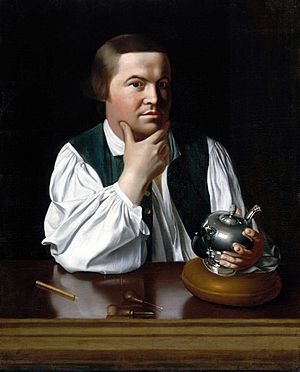
John Singleton Copley, Portrait of Paul Revere. c. 1768–1770, Museum of Fine Arts, Boston
|
|
| Born | January 1, 1735 (O.S.: December 21, 1734) |
| Died | May 10, 1818 (aged 83) Boston, Massachusetts, U.S.
|
| Occupation | Silversmith, colonial militia officer |
| Political party | Federalist |
| Spouse(s) |
|
| Children |
|
| Parent(s) |
|
| Signature | |
Paul Revere (born January 1, 1735 – died May 10, 1818) was an American silversmith, engraver, and a key figure in the American Revolution. He is most famous for his exciting midnight ride in April 1775. During this ride, he warned colonial soldiers that British forces were coming, right before the important battles of Lexington and Concord. This famous event was later told in a poem by Henry Wadsworth Longfellow called "Paul Revere's Ride".
When he was 41, Revere was a successful silversmith in Boston. He helped create a system to watch the British military and send out warnings. Revere also served as an officer in the Massachusetts militia. After the war, he went back to his silversmith business. He used his earnings to start new businesses, like making iron, bronze bells, and cannons. In 1800, he was the first American to successfully make copper sheets for ships.
Contents
Early Life and Learning
Paul Revere was born in the North End of Boston on January 1, 1735. His father, Apollos Rivoire, was a French Huguenot (a French Protestant) who came to Boston when he was 13. He learned the silversmith trade from John Coney. Before marrying Deborah Hitchborn in 1729, Apollos changed his name to Paul Revere. Their son, Paul Revere, was the third of 12 children.
Revere grew up surrounded by his mother's large family. He never learned his father's French language. At age 13, he left school to become an apprentice to his father. Working as a silversmith helped him meet many different people in Boston. These connections became very useful when he joined the American Revolution.
His father died in 1754. Paul was too young to officially take over the silver shop. In 1756, during the French and Indian War, he joined the army. He might have done this because the economy was weak, and army service offered steady pay. He became a second lieutenant in an artillery group. He spent the summer at Fort William Henry in New York. He did not stay in the army long. He returned to Boston and took over the silver shop himself. In 1757, he married Sarah Orne. They had eight children, but only one, Mary, lived longer than her father.
The Start of the Revolution (1765–1774)
Revere's business struggled after the Seven Years' War because the British economy was in a downturn. Things got worse when the Stamp Act of 1765 hurt the Massachusetts economy. To earn more money, he even started working as a dentist. He learned this skill from a surgeon. One of his patients was Joseph Warren, a local doctor and political leader. Revere and Warren became close friends. They shared political views and were both active in the same Masonic lodges.
Revere was not one of the first organizers against the Stamp Act, but he knew them well. These organizers were mostly workers and craftspeople. In 1765, a group called the Sons of Liberty formed, and Revere joined them. From 1765 on, he created engravings and other items with political messages. These included a picture of British troops arriving in 1768. He also made a famous picture of the Boston Massacre in March 1770. This picture was based on a drawing by Henry Pelham.
In 1770, Revere bought a house, which is now a museum, in Boston's North End. This house gave space for his growing family. He kept his shop nearby. Sarah, his first wife, died in 1773. On October 10 of that year, Revere married Rachel Walker. They had eight children together, but three died young.
In November 1773, the ship Dartmouth arrived in Boston. It carried the first shipment of tea under the new Tea Act. This law allowed the British East India Company to ship tea directly to the colonies. This upset colonists because it bypassed local merchants and still had taxes. Revere and Warren helped organize a watch over the Dartmouth. They wanted to stop the tea from being unloaded. Revere was one of the leaders in the Boston Tea Party on December 16. During this event, colonists dumped tea from three ships into the harbor.
From 1773 to 1775, Revere worked as a messenger for the Boston Committee of Public Safety. He traveled to New York and Philadelphia to share news about the problems in Boston. He made at least 18 such rides. British officials knew about his role as a messenger.
In 1774, General Thomas Gage, the military governor of Massachusetts, closed the port of Boston. He also made private citizens provide housing for soldiers in their homes. During this time, Revere and about 30 other "mechanics" (skilled workers) met secretly. They met at the Green Dragon to watch the movements of British soldiers. Revere also regularly made political engravings for a Patriot magazine.
In December 1774, he rode to Portsmouth, New Hampshire. There were rumors that British troops were landing there. This ride is known as the Portsmouth Alarm. The rumors were false, but his ride led locals to raid Fort William and Mary. They took its gunpowder supply, which was a success for the rebels.
The Famous Midnight Ride
Paul Revere's most famous act was his ride on the night of April 18, 1775. He rode from Boston to Lexington to warn Patriot leaders, Samuel Adams and John Hancock, that British troops were marching to arrest them. He also warned the local militia (citizen soldiers) that the British were coming to seize their weapons and gunpowder in Concord.
Revere arranged for signals from the Old North Church in Boston: "one if by land, two if by sea." This meant one lantern if the British came by land, and two if they came by boat. On that night, two lanterns were lit, showing the British were crossing by sea. Revere then set off on horseback. He rode through towns like Medford and Lexington, shouting warnings. He was joined by other riders, including William Dawes and Samuel Prescott. Revere was captured by a British patrol, but Dawes and Prescott continued the warning. Their brave actions helped the colonial militia prepare for the battles of Lexington and Concord, which marked the start of the American Revolutionary War.
During the War
After the battles of Lexington and Concord, Boston was under siege by the British. Revere could not return to the city. He stayed in Watertown with his family. He wanted to join the Continental Army but was not given a high rank. Instead, he worked as a messenger for the provincial congress. He also printed local money to pay the soldiers around Boston.
There was a great need for gunpowder. In November 1775, the congress sent Revere to Philadelphia. He was to study the only powder mill in the colonies. He hoped to build another one in Massachusetts. The mill owner, Oswald Eve, showed Revere around but wanted a lot of money for detailed plans. Revere still learned useful things from his visit. He also got plans for another powder mill. This helped Revere build a powder mill in Stoughton (now Canton). This mill made tons of gunpowder for the Patriot cause.
Revere's friend, Joseph Warren, died in the Battle of Bunker Hill in June 1775. Warren's grave was not marked. In March 1776, after the British left Boston, Revere and Warren's family found a grave with two bodies. Revere identified Warren's body because he had put a false tooth in Warren's mouth. Warren was then given a proper funeral.
Militia Service
When Revere returned to Boston in 1776, he became a major in the Massachusetts militia. A month later, he moved to the artillery (cannon unit). In November, he was promoted to lieutenant colonel. He was stationed at Castle William, protecting Boston harbor. He often helped maintain the fort's weapons. He even designed a tool to measure cannonballs. Life at Castle William was quiet, but sometimes there were complaints against Revere. In 1777, he escorted prisoners from the Battle of Bennington to Boston. He also went to Rhode Island briefly.
In August 1778, Revere's unit joined French and American forces. Their goal was to capture the British base at Newport, Rhode Island. Revere's unit set up and maintained artillery batteries. The plan failed when a storm scattered the French fleet. Revere's unit returned to Boston.
The Penobscot Expedition
In June 1779, the British set up a new base in Penobscot Bay in what is now Maine. Massachusetts leaders sent a large force to remove them. This mission was a disaster. The land and naval commanders argued and could not agree on a plan. British reinforcements arrived, and the entire Massachusetts fleet was destroyed. Revere led the artillery units. He helped capture Bank's Island, which allowed cannons to reach British ships. He then moved the cannons to a new position. Revere wanted to attack the fort, but the general chose a siege instead. After more disagreements, the general decided to retreat.
The British ships were spotted the next day. The fleet quickly retreated up the Penobscot River. Revere and his men were put ashore, and their ships were destroyed. Revere was separated from his men. He managed to gather most of his troops and returned to Boston in August. Revere faced several charges, some from enemies he had made. The first hearings were unclear, and he was asked to resign. He kept asking for a full court-martial to clear his name. In February 1782, a court martial finally heard the case and found him innocent.
Later Years: Business and Politics
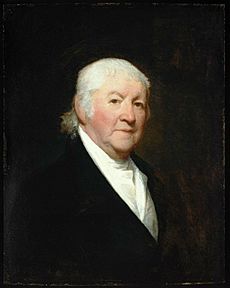
After the war, Revere became interested in working with metals other than gold and silver. By 1788, he used profits from his silver business to build a large furnace. This allowed him to work with more metals at higher temperatures. He opened an iron foundry in Boston's North End. He made useful iron items like stove backs and fireplace tools for many people. When he started ironworking, Revere became more than just a craftsman; he became a business owner and manager.
New Technologies
Revere's success came from his good timing, natural skill, and research. He also used his experience from silverworking. He was able to make his work more efficient and adapt to new technologies. Boston was becoming a center for industry, which helped him. Many skilled business owners worked together to share knowledge and improve technology. By learning from other metalworkers, Revere mastered new techniques throughout his career.
Working with Employees
One big change for Revere was how he managed his workers. Earlier, he mainly used the apprenticeship model, where young people learned a trade. As his business grew, he hired employees who worked for wages. Many factory owners found this change difficult. Workers at the start of the Industrial Revolution often saw themselves as skilled craftspeople. They wanted respect and freedom. Revere, being a craftsman himself, avoided many problems. He allowed flexible work hours, paid fair wages based on skill, and even provided drinks on the job.
Making Bells, Cannons, and Copper
After becoming good at iron casting, Revere saw a new need for church bells. Many new churches were being built during a religious movement called the Second Great Awakening. Starting in 1792, he became a famous bell maker in America. He worked with his sons, Paul Jr. and Joseph Warren Revere, in their company, Paul Revere & Sons. This company made the first bell in Boston and hundreds more, many of which are still used today.
In 1794, Revere expanded his business again. He learned to cast cannons for the government and private customers. Even though the government sometimes paid him late, their large orders encouraged him to find more products for the military.
By 1795, a growing part of his business came from copper bolts and spikes for building ships. In 1801, Revere became a leader in making rolled copper. He opened North America's first copper mill in Canton. Copper from his Revere Copper Company was used to cover the dome of the Massachusetts State House in 1802. His copper and brass business grew and eventually became a large company called Revere Copper and Brass, Inc.
Standardized Production
When Revere was a silversmith, he made custom-made items. As he moved to ironworking, he needed to make more standardized products. This made production cheaper. He used identical molds for items like stoves and ovens. However, he did not make everything exactly the same. His bells and cannons were unique and needed special adjustments. Even his mass-produced items were not perfectly identical due to the technology and skills of the time. His methods were well organized, even if the products varied a little. He learned that his furnace could be used flexibly to make different products, but an expert could get consistent results by following standard steps.
Freemasonry
Paul Revere was a Freemason, a member of Lodge St. Andrews in Boston. He joined sometime between 1756 and 1769. Joseph Warren and William Palfrey were also members of this lodge.
He later became the Grand Master of the Freemasons of Massachusetts from 1795 to 1797. During this time, Revere, along with Governor Samuel Adams, placed a box of special items under the cornerstone of the Massachusetts State House on July 4, 1795.
Politics and Final Years
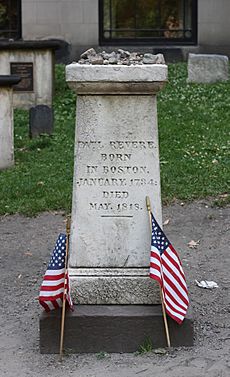
Revere stayed involved in politics throughout his life. His business plans in the late 1780s were often held back by a lack of money. He liked Alexander Hamilton's ideas for banks and industry. Revere became a strong Federalist, wanting a strong economy and nation. He was especially interested in protective tariffs, which are taxes on imported goods to help local businesses. In 1808, he and his son asked Congress for protection for his copper business. Even after retiring in 1811, he continued to discuss political issues. In 1814, he asked Boston's craftspeople to help protect the city during the War of 1812.
Paul Revere died on May 10, 1818, at age 83, at his home in Boston. He is buried in the Granary Burying Ground on Tremont Street.
Legacy
After Revere's death, his oldest surviving son, Joseph Warren Revere, took over the family business. The copper works he started in 1801 still exists today as the Revere Copper Company.
Revere's original silverware, engravings, and other works are highly valued. They can be seen in museums like the Museum of Fine Arts, Boston and the Metropolitan Museum of Art. The Revere Bell, given to the Church of St. Andrew in Singapore in 1843 by his daughter, is now in the National Museum of Singapore. This is the only bell made by Revere's company outside the United States.
The towns of Revere, Massachusetts, and Revere, Minnesota, are named after him. So are Revere Beach in Massachusetts, Revere Avenue in The Bronx, New York City, and Paul Revere Road in Arlington, Massachusetts.
A 25-cent U.S. postage stamp from 1958 honors Paul Revere. He also appears on the $5,000 Series EE U.S. Savings Bond.
Images for kids
See also
 In Spanish: Paul Revere para niños
In Spanish: Paul Revere para niños
- Israel Bissell, who rode to Philadelphia with news of the battles of Lexington and Concord
- Sybil Ludington, who is said to have performed a similar ride in New York
- Jack Jouett, rode to warn Thomas Jefferson and the Virginia legislature of a British raid
- Revere Bells, one of Revere's highest-profile products
- Revere Copper Company, the business founded by Paul Revere and later managed by his son and grandsons
- Johnny Tremain, 1943 children's novel by Esther Forbes set in Boston prior to and during the outbreak of the Revolution


